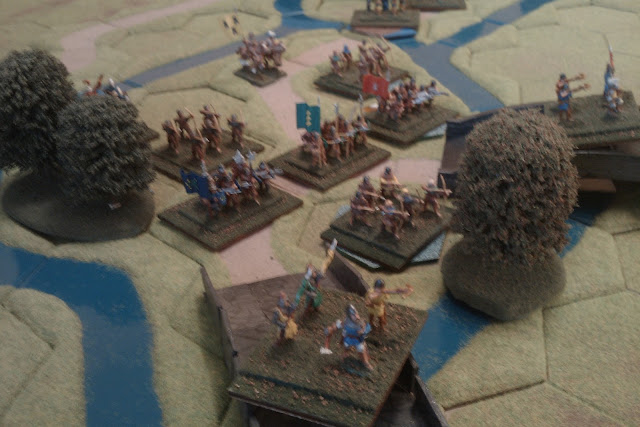So, no, not THE cleanse the causeway, this was a 14th century border clash using Ron's Hexed Basic Impetus variant. (Available at left.) I had thought that the two games the week before last were really good but they were but a moon cast shadow to this one. An epic 4 hour, 15 turn game that teetered on a knife edge of victory or defeat for either side for the last 3 turns.
If I could type in a corny Scottish dialect I'd be tempted to write this as a 1st person account of a real event. Luckily for you all, I can't and therefore won't.
Overview at the end of Turn 2. The casualty figures indicate disordered Scots units.
The game was Island Stand from CS Grant's Programmed Scenarios. Basically this involves an un-fordable river with an island in the middle. Bridges cross the river from the island to the Northern and Southern banks. The attacker is tasked with controlling a route across the river, the defender with preventing this. The attacker is aided by a small force of light infantry which has managed to cross off table. The original map called for various buildings but Ron chose to deploy woods instead which seemed very appropriate. If the Scots were the defenders, I would have tried to pull a Stirling Bridge, doing my best to shelter my schiltrons behind the trees, counter attacking any English force that crossed but the toss indicated an English defence.
Drawing on what limited knowledge that I could drag up about the poorly recorded reign of King Ross (most historians believe that David Bruce succeeded his father directly), I decided that the battle probably took pace in late 1330 as a Scots raiding force was on its way home from an incursion into England, only to find its way barred.
The English force was composed of a unit of knights, three of bowmen, three of spear/billmen, 1 of Welsh light infantry and 4 of skirmishing mercenary crossbowmen. A roll determined that the two southern bridges had been barricaded. Since the rules don't include barricades we declared them to be difficult terrain which was bad news for my pikemen.
Once again my cell phone camera skills were not up to the task.
The Scots fielded 3 Schiltrons (double units), 3 Highland Clans, 3 units of skirmishing archers and an unlikely bombard. (The latter was supposed to have been a unit of cavalry but there appears to have been a packing error.) Two archer and 1 Highland unit started across the river.
My plan was fairly simple, use my archers and bombard to pick at the enemy while the Schiltrons and Highlanders stormed the barricades. Once again the English archers were a major factor stalling schiltrons and forcing one clan out of the battle. The first assault on main bridge faced a tough fight but eventually took the barricade and then waited for an appropriate moment to cross it and drive forward. Once the 2nd schiltron had ponderously crossed the table under an arrow storm and was ready to attack, the signal was given and both started forward. After a tough fight the left hand attack finally took and crossed the barricade only to be broken by counter attacking English billmen. In the center, the schiltron crossed the barricade but before they could reorder, a counter attack by English infantry drove them back across the barricade.
While I regrouped and my Highlanders traded a desultry bowfire with longbowmen in a wood, the attention shifted to the far side where my archers were dueling across the river with Ron's while the Highlanders closed on the bridge. Ron's Welsh were unlucky enough to be hit with the first canon ball of the game but a unit of mercenary crossbowmen still barred the way. Neither lasted as my clan stormed forward routing unit after unit. Faced with another bridge, longbowmen and mounted knights, the victorious Highlanders slipped into a patch of woods and sent their handful of archers to the front to snipe at the English.
King Ross and his standard bearer and nephew, Sir Thomas Macfarlane, survey the battle.
By now, the Scots morale was looking a little shaky, even the bombard had been silenced by bowfire, but the English were not unscathed, the rout of a longbow unit under fire from the despised Highland archers being particularly notable. It was do or die. Putting himself at the head of the last schiltron the King led them forward. Once again an English counter attack hit them as they struggled over the barricade.
Crunch time.
This time, after a prolonged melee, the English were forced back, once and then again, pushing their way through and disordering the archers and knights behind them with the Scots hot on their trail. Into the flank of the knights crashed the Scots. Nip and tuck! Both armies were on the edge of their break point. Whoever lost the next unit would lose the battle. Unbelievably, both sides kept making critical cohesion tests or failing to hit. For 3 rounds the tired men traded blows with no result, the 3rd English infantry unit, recalled from the bridge maneuvered into place despite the fire of Scots archers from across the river, and crashed into the flank of the Scots pikes. Still the Scots held! Finally though, exhaustion set in and the remaining Scots spearmen broke, flooding back across the bridge. King Ross barely escaped with his life, but escorted by Highland archers and swordsmen he made his way off the field.






Ross,
ReplyDeleteWhat an exciting battle!
Those are the ones that we remember the best.
Thanks for the report.
John
John You are right. A good reminder that its not necessarily the big ones that are the most memorable or the most fun.
ReplyDelete-Ross
Hi Ross
ReplyDeleteExcellent report, and the pictures did justice to the battle.